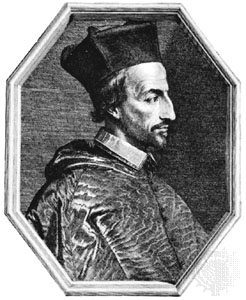Cornelius Jansen
|
|
Cornelius Jansen, often known as Jansenius (October 28, 1585 — May 6, 1638) was bishop of Ypres and the father of the religious revival known as Jansenism.
He was born of humble Catholic parentage at Accoy in the province of Utrecht in the Netherlands. In 1602 he entered the university of Leuven, then in the throes of a violent conflict between the Jesuit, or scholastic, party and the followers of Michael Baius, who swore by St Augustine. Jansen ended by attaching himself strongly to the latter party, and presently made a momentous friendship with a like-minded fellow-student, Jean du Vergier de Hauranne, afterwards abbot of Saint Cyran.
After taking his degree he went to Paris, partly to improve his health by a change of scene, partly to study Greek. Eventually he joined Du Vergier at his country home near Bayonne, and spent some years teaching at the bishop's college. All his spare time was spent in studying the early Fathers with Du Vergier, and laying plans for a reformation of the Church.
In 1616 he returned to Leuven, to take charge of the college of St Pulcheria, a hostel for Dutch students of theology. Pupils found him a somewhat choleric and exacting master and a great recluse from academic society. However, he took an active part in the university's resistance to the Jesuits, for they had established a theological school of their own in Leuven, which was proving a formidable rival to the official faculty of divinity. In the hope of suppressing their encroachments, Jansen was sent twice to Madrid, in 1624 and 1626; the second time he narrowly escaped the Inquisition. He warmly supported the Catholic missionary bishop of the Netherlands, Rovenius, in his contests with the Jesuits, who were trying to evangelize that country without regard to the bishop's wishes. He also crossed more than once the Dutch Presbyterian champion, Gisbertus Voetius, still remembered for his attacks on René Descartes.
Antipathy to the Jesuits brought Jansen no nearer Protestantism; on the contrary, he yearned to beat them with their own weapons, chiefly by showing them that Catholics could interpret the Bible in just as mystical and pietistic a manner. This became the great object of his lectures, when he was appointed regius professor of scriptural interpretation at Leuven in 1630. Still more was it the object of his Augustinus, a bulky treatise on the theology of St Augustine, barely finished at the time of his death. Its preparation was his chief occupation since his return to Leuven.
But Jansen, as he said, did not mean to be a school-pedant all his life; and there were moments when be entertained political ambitions. He looked forward to a time when Belgium would throw off the Spanish yoke and become an independent Catholic republic on the model of the Protestant United Provinces. These ideas became known to his Spanish rulers, and to assuage them he wrote a philippic called the Mars gallicus (1635), a violent attack on French ambitions generally, and on Cardinal Richelieu's indifference to international Catholic interests in particular. The Mars gallicus little helped Jansen's friends in France, but it reversed Madrid's wrath with Jansen's person; in 1636 he was appointed bishop of Ypres. Within two years he was cut down by a sudden illness; the Augustinus, the book of his life, was published posthumously in 1640.de:Cornelius Jansen es:Cornelio Jansen fr:Cornelius Jansen it:Giansenio nl:Cornelius Jansenius ja:コルネリウス・ヤンセン

